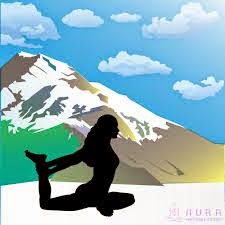By:
Virginia Iversen, M.Ed
Shiva is
one of the primary Hindu deities. In many ways, Shiva is the quintessential
Yogi. He is often depicted with a trident staff in his right hand and a
crescent moon behind his head. The energy around Shiva scintillates with an
electric blue hue, the color of deep meditation. To engage with Shiva’s energy
through song, mantra repetition or worship, is to invoke the energy of
transformation. Shiva is known in Hinduism and in the Yogic scriptures as the
great transformer. He is said to have the ability to illuminate that, which
holds back a seeker, both on the material plane and on the spiritual level of
existence.
To engage
in the process of transformation, it is first necessary to clarify what you
would like to transformation. You may a certain level of dissatisfaction or
unease with certain aspects of your life. Or you may long to fulfill
longstanding dreams or goals that have yet to be accomplished. In order to
transformation the external circumstances of your life, it is necessary to
excavate the underlying beliefs that are holding you back. It is also often
necessary to come to terms with any number of painful or otherwise unresolved
emotional experiences, which are preventing you from moving forward in your
life.
In
business organizational terms, the health of a business can be defined as an
organization’s ability to truly align itself with its highest aspirations and
to implement the steps necessary to achieving those goals. In the same way, you
are the leader of a micro- corporation, your own life! The first step to
restructuring the business of your own life is to clarify what needs to be
transformed. Although there is a great deal of emphasis on being in a constant
state of “doing” in our culture today, sometimes it is necessary to slow down
in order to drop into the fertile, creative void within; the place where
inspiration naturally arises.
During
the flowing series of Yoga postures that comprise a balanced Yoga class, you will
most likely move from a series of Sun Salutations to standing postures,
balancing poses, backbends, inversions, and seated forward folds. In many
vigorous forms of Yoga, the emphasis is frequently placed on the strengthening
standing asanas and core exercises, instead of the more internal seated forward
bends. However, invoking the transformative energy of Shiva is also quite
powerful in the practice of the more internally focused, seated Yoga postures,
such as Tortoise Pose.
*
Tortoise Pose or Kurmasana
Kurmasana
is also known as Tortoise Pose because it resembles the position of a tortoise
when it contracts into its shell. In the same way, by allowing yourself to
withdraw your senses from external stimuli during your practice of Tortoise
Pose, you will enable yourself a few moments to drop into the creative void
within your own heart. From this place, you are afforded the opportunity to
witness a spontaneous welling up of inspiration and wisdom from the depths of
your own being.
The
physical benefits of Tortoise Pose include profoundly stretching out the
shoulders, upper back, neck and groin muscles, in addition to gently
stimulating the processes of digestion. Tortoise Pose may also relieve some
headaches, as it facilitates the flow of fresh blood and oxygen through the
brain. Kurmasana, or Tortoise Pose, is usually practiced towards the end of a
Yoga class and prior to Shavasana. As a counter-pose to Kurmasana, it is
advisable to practice a back bending Yoga posture, such as Fish Pose, either prior
to or just after your practice of Tortoise Pose. When you are ready to practice
Kurmasana, come to a comfortable seated position on your Yoga mat.
If your
hips are tight, place a folded blanket underneath you for support. Place your
legs in a diamond position with the soles of your feet gently touching. With an
inhale; raise your hands over your head in Prayer Position. With your next
exhale, bend forward and place your lower arms underneath your calves with the
palms of your hands flat on your Yoga mat. If this is not possible today,
simply place your hands flat on your mat on the outside of your knees or
calves. If you have the flexibility to bind in this pose, clasp your hands
behind your back. Hold Kurmasana for three to five complete, full breaths. When
you have completed your practice of Tortoise Pose, release the posture and come
back to a comfortable seated position on your Yoga mat.
Virginia
Iversen, M.Ed, has been practicing and studying the art of Yoga for over twenty
years. She lives in Woodstock, New York, where she works as a writer and an
academic support specialist. She is currently accepting Yoga and health-related
writing orders and may be contacted at: enchantress108@gmail.com.

